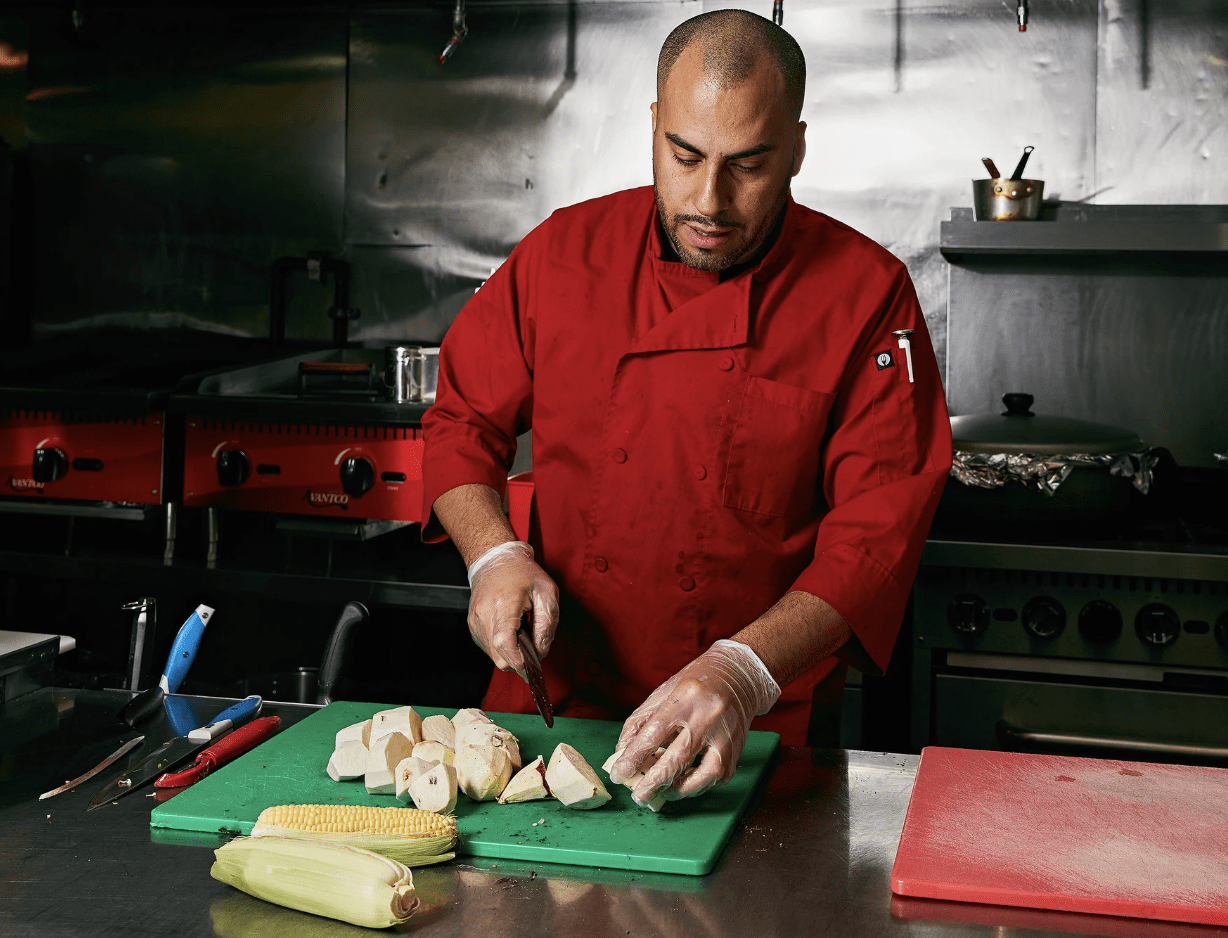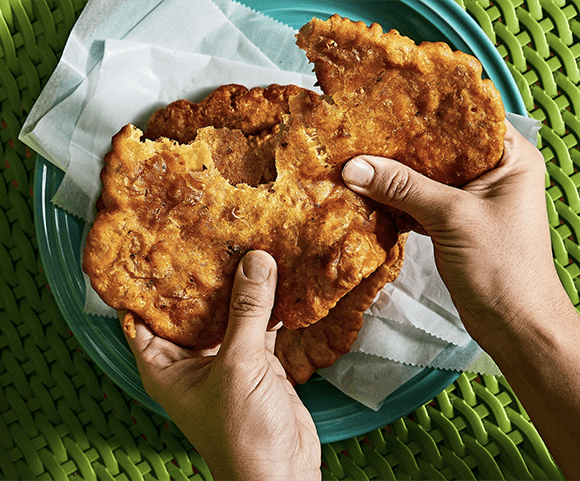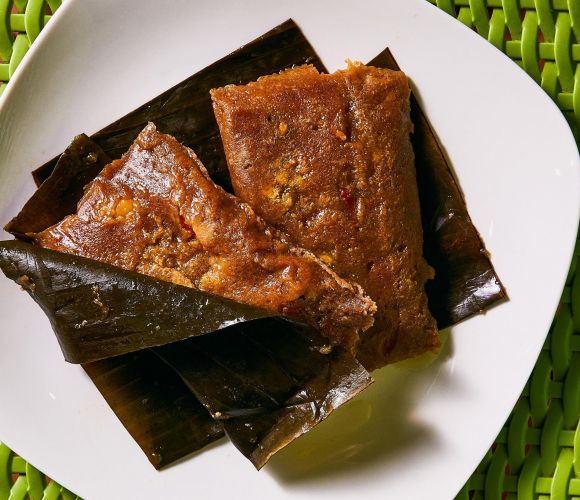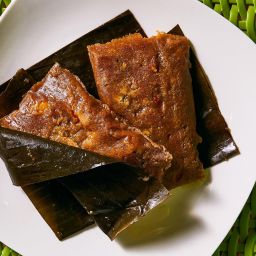It is true that the bacalaitos at the Freakin Rican in Astoria, Queens, are not quite as big around as the ones you will see browning in veritable caldrons of oil over wood fires at kiosks scattered along the beach road in Piñones, outside San Juan. These flattened cod fritters are the size of pie plates in Puerto Rico, while in Queens they are roughly the diameter of a coffee can.
Dimensions aside, they give off all the right signals. They are the color of a corn muffin, with green specks of chopped cilantro under the surface that let you know they are not made from Goya’s mix. They don’t leave your fingertips entirely free of grease, but they come close. They have an exterior crunch that surrenders quickly to the firm, chewy interior of mashed salt cod; the texture is less fried dough than fish taffy.

You could start to build a business around bacalaitos like these. That, in fact, has been Derick López’s plan for some time now. Mr. López, who was born in Puerto Rico and raised in the South Bronx, is the Freakin Rican’s chef and, with his husband, Victor Vargas, its owner. About four years ago, armed with picnic coolers and a couple of folding tables, the two men began selling a short menu of Puerto Rican staples at the street fairs that seem to infiltrate a different New York thoroughfare each weekend. As they promoted the Freakin Rican catering operation, the Freakin Rican product line, the Freakin Rican Facebook page and the Freakin Rican YouTube channel, they saved their earnings so they could found the Freakin Rican restaurant.
After a false start in another part of Queens, it opened a short distance from the Museum of the Moving Image one year ago this month. The dining room has 19 seats. The banana-plant wallpaper on the left wall is reflected in the mirrors on the right. In between are some metal chickens and bright-green figurines of coquís, the little frogs that chirp from every Puerto Rican tree. Diners sip on tropical-fruit shakes or bottles of Kola Champagne, Coco Rico and Malta India, the Harry, Ron and Hermione of Puerto Rican soft drinks. Héctor Lavoe may be playing over the speakers, or Víctor Manuelle, not so loudly that they can’t be drowned out by the sounds of a small number of employees singing “Happy Birthday” while wielding a tambourine and a pair of maracas.

After a false start in another part of Queens, it opened a short distance from the Museum of the Moving Image one year ago this month. The dining room has 19 seats. The banana-plant wallpaper on the left wall is reflected in the mirrors on the right. In between are some metal chickens and bright-green figurines of coquís, the little frogs that chirp from every Puerto Rican tree. Diners sip on tropical-fruit shakes or bottles of Kola Champagne, Coco Rico and Malta India, the Harry, Ron and Hermione of Puerto Rican soft drinks. Héctor Lavoe may be playing over the speakers, or Víctor Manuelle, not so loudly that they can’t be drowned out by the sounds of a small number of employees singing “Happy Birthday” while wielding a tambourine and a pair of maracas.
If you have spent any time at all on the trail of chicharrones, mofongo, sancocho and other wonders of the Puerto Rican kitchen, you know that Astoria is not a primary hunting ground for any of them. You also know, though, that blinking-light cuchifritos parlors and family-run cocina criolla luncheonettes have been disappearing from the Bronx, East Harlem and the Lower East Side over the past few decades, along with many of their customers. The Puerto Rican population in New York peaked around 1990, when residents of the old barrios began to flow to the suburbs in large numbers, according to Laird W. Bergad, the director of the Center for Latin American, Caribbean and Latino Studies at City University of New York Graduate Center.
Beacons of Puerto Rican cuisine still survive; Casa Adela, for instance, is still busily dispensing chickens from its venerable lemon-yellow rotisserie on Avenue C, despite the death last year of its founder, Adela Fargas. But there are not so many of these places left that we can take an unlimited supply of tostones and mojo de ajo for granted, either.
The Freakin Rican developed its act on the street-fair circuit, but it applied the same tactics that succeed at Smorgasburg and similar urban foraging grounds, where the ideal dish can be held in one hand, gets immediate attention, costs under $10 and can serve as a plank in a branding platform. This may explain why appetizers are the strong suit on the Freakin Rican menu.
The sorullitos, Puerto Rico’s answer to hush puppies, are an exception; they are dense and dry, as if the cornmeal hadn’t absorbed enough water. Mr. López’s alcapurrias, though, are very good, even if the picadillo that runs down the middle of a tube of mashed fried plantains like the graphite in a pencil could be seasoned a little more forcefully. And his pasteles are exceptional.
Pasteles are structured like tamales. Where the masa would be, Mr. López makes a sweet, enjoyably gummy mash of green plantains, taro root and kabocha squash. The filling is a soft, rich vein of stewed pork shoulder with ham, bacon, red peppers and green olives. Rolled up in a banana leaf, these pasteles probably deserve their own float in the Puerto Rican Day Parade.
Mr. López fries chicken in two styles. One, the chicharrones de pollo, is traditional. The other, the Freakin Crispy Wings, is not. Each has its rewards. The chicharrones, hacked into three-bite hunks, taste of cider vinegar and garlic powder and have a smooth, achiote-tinted buttermilk crust that breaks open with a pleasing crackle. The Freakin Crispy Wings are spicier, and the shell is thicker and more deeply crevassed. These wings may owe more to Atlanta than to Mayagüez, although you can get them with a guava barbecue sauce that’s reasonably tropical.
Leave behind these appetizers, the core of the street-fair business, and the menu can start to appear unsteady. At dinner, the main courses tend to be fairly plain fried or grilled meat. Grilled pork chops splashed with mojo can be dry and dull, and the grilled chicken breasts are not much more interesting. Baked pork ribs in a sweet barbecue sauce are tender enough, but they aren’t very persuasive.
On several nights, I found myself gazing longingly at the lunch specials on the back of the menu, wondering why I couldn’t have a brick of pastelón for dinner. (I came back for it one Thursday afternoon, and was glad I did.) Until more long-cooked dishes like it appear at dinnertime, consider a bowl of sancocho. Listed as “vegetable root soup” for $7, it doesn’t sound like much of a meal. But it is a grab bag of a stew with at least two kinds of meat, great hunks of taro and yuca, a couple of inches of corn on the cob and a magical squash broth that has the consistency of heavy cream and the color of very ripe mango.
In the unlikely event that you finish it and the bowl of rice that comes with it and then cry out for more, the Freakin Rican has just the thing for you: mofongo. A dome of mashed plantains possessed by garlic, the mofongo is cooked to order to keep the crunchy bits crunchy and the whole thing from getting boggy. You can have it with chicharrones or sliced roast pork, which leaves behind a happy impression of garlic, oregano and salt.
If you have come for a birthday, a candle stuck in the meringue icing of a tres leches cake is probably in your future. If not, flan and espresso will do, and a bag of pasteles for tomorrow.





